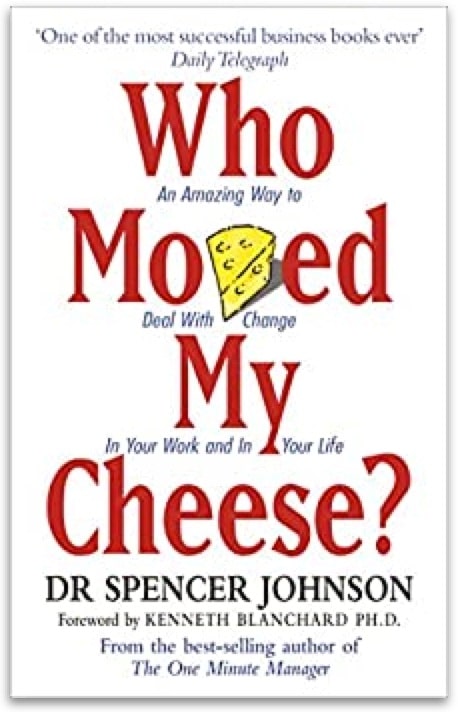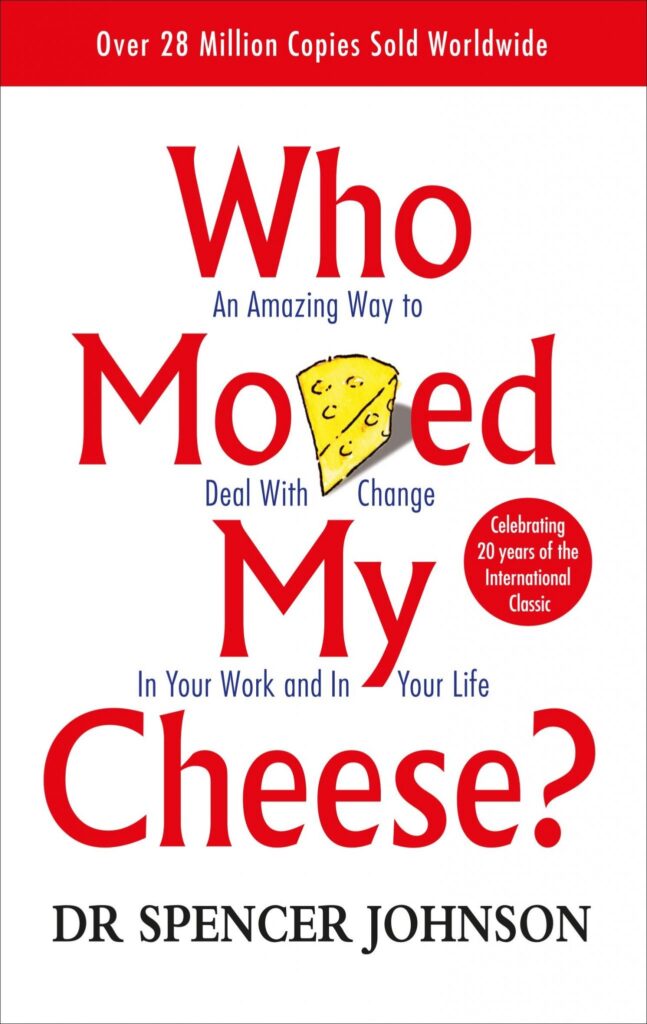As you navigate through “Embracing Change: A Recap of ‘Who Moved My Cheese’ Book”, you’ll uncover the key insights woven into this popular book’s narrative. This story will guide you through the understanding that life is a constant ebb and flow of change, and resisting this natural process only breeds unhappiness. It teaches that adaptability, courage, and openness to new opportunities, not fear, are the tickets to flourishing in the face of change. The tale also underscores the significance of personal responsibility, continuous learning, and a positive outlook as the foundation of your personal success and happiness. This recap serves as a compass, steering you to confront change with a renewed vigor and a resilient mindset.

Change Is Inevitable
Understanding the inevitability of change
Change, as the saying goes, is the only constant. This notion is amplified in ‘Who Moved My Cheese’ where change is shown to be an inevitable part of life. Whether we like it or not, change occurs in every sphere of our lives – in our personal lives, in the workplace, in society, and even within ourselves. The initial reaction is often resistance as we are wired to maintain the status quo, as it’s comfortable and familiar. But the important thing to remember is that change isn’t something to be feared, it’s a natural part of growth and existence.
The consequences of resisting change
When we resist change, we often find ourselves stuck, frustrated, and unhappy. The book teaches us that doggedly holding on to the past or dwelling on how things used to be, not only inhibits personal advancement but can also lead to a life of regret and stagnation. This was a significant theme in the book, with the characters who resisted change finding life harder than it needed to be.
The benefits of accepting change
The opposite of resisting change is accepting it, and there are many benefits to doing so. Those who gracefully accept change often find new opportunities and adventures. They are more likely to evolve and grow as individuals. Through acceptance, life becomes more dynamic, and a certain level of excitement and anticipation is cultivated. In the book, the characters who embraced change were the ones who found new cheese, symbolic of new opportunities and adventures.
Adaptability Is Crucial
Why adaptability matters in the face of change
Being adaptable in the face of change is not just helpful, it’s crucial. Adaptability is essentially the ability to quickly adjust to new situations and environments. It helps us navigate through change in a more efficient and less stressful way. Those who are adaptable are often more resilient, with the capacity to recover quickly from difficulties or changes in circumstances.
Examples of adaptability in ‘Who Moved My Cheese’
There are plentiful examples of adaptability as a key success trait throughout ‘Who Moved My Cheese’. The characters who were able to adjust quickly to their cheese being moved symbolize individuals who are quick to adjust to changes in their lives. They did not waste time on grief or frustration but instead quickly made efforts to adapt to their new circumstances.
How to cultivate adaptability
Cultivating adaptability begins with understanding and accepting the inevitability of change. It encourages a mindset that is open to new experiences and learning. Maintaining a level of curiosity and willingness to step out of one’s comfort zone is key. It’s also important to remain solution-oriented and seek out ways to navigate through new situations. And remember, it’s OK to make mistakes along the way, as they are also a part of the learning process.
Let Go of Fear
How fear restricts our ability to respond to change
Fear is a powerful emotion that can control our actions and decision-making processes. It’s natural to fear the unknown, including change, but succumbing to these fears can stunt our growth. When we allow fear to dominate, we may miss out on potential opportunities and experiences. Our ability to respond to change, therefore, becomes hampered and we may find ourselves unable to move forward.
Methods for overcoming fear featured in the book
‘Who Moved My Cheese’ features practical methods for overcoming fear. One particularly effective method was shifting perspective on fear. Instead of seeing change as something threatening, it encouraged readers to view change as an avenue for fresh opportunities and experiences. The book suggests adopting a positive attitude towards fear, treating it as a challenge and a chance for personal development rather than a barrier.
Practical ways to let go of fear in our lives
Letting go of fear in our lives involves gently pushing ourselves out of our comfort zones and slowly taking risks. It may be helpful to expose ourselves to new experiences gradually. Reflecting on past successes can also be a strong motivator. Remember, all change comes with a degree of uncertainty and discomfort, but facing these fears will help cultivate courage and resilience.
Embrace New Opportunities
Recognizing and seizing new opportunities in change
Change can often pave the way for fresh prospects and opportunities. Not all changes may seem positive at the onset, but with time and a bit of perspective, the benefits often reveal themselves. By staying open-minded, you allow yourself the chance to recognize and seize these new opportunities.
Stories of characters embracing opportunities in the book
In ‘Who Moved My Cheese’, the characters who embraced changes were the ones who found new opportunities, represented by the discovery of fresh cheese. Their willingness to step out of their comfort zones and explore unfamiliar territories was rewarded with new experiences and growth.
Tips on welcoming new opportunities in real life
To embrace new opportunities, you must first be open to change and willing to step out of your comfort zone. Learning to view change with a positive outlook is essential. Also, it can be beneficial to develop a proactive approach, actively seeking out new experiences instead of passively waiting for them to come your way.

Take Personal Responsibility
The concept of personal responsibility in ‘Who Moved My Cheese’
Personal responsibility is a significant theme in ‘Who Moved My Cheese’. The book emphasizes that each individual is responsible for their own happiness and success. You cannot blame others for your misfortunes or rely on them for your happiness. You have the power to choose how you react to changes and decide for yourself what the best course of action is.
Why personal responsibility is key to managing change
Personal responsibility is key to managing change because it returns the control back to the individual. Instead of feeling helpless in the face of change, taking responsibility for one’s own reactions and actions empowers individuals to handle change more effectively.
Ways to take control of your life amid changes
To take control of your life amid changes, start by acknowledging that change is a part of life and it’s okay to feel uncomfortable. Instead of resisting change, embrace it, and adapt accordingly. Implement strategies to handle fear and stress associated with change and adopt a proactive approach to seek out novel opportunities and experiences.
Importance of Continuous Learning
Character growth through learning in the book
In ‘Who Moved My Cheese’ the characters that thrive in the face of change are those who embrace learning. These characters evolve, adapt and handle challenges efficiently because they are open to learning from their experiences – they convert setbacks into growth opportunities.
Why ongoing learning is a success strategy during change
Continuous learning is vital during periods of change as it enables us to adapt more quickly and effectively. It enhances our ability to understand and navigate new situations, fosters resilience, exposes us to new ideas, and inspires innovation.
How to maintain a learning mindset in various life scenarios
Maintaining a learning mindset involves staying curious and being open to new experiences. It includes embracing and learning from our mistakes, seeking feedback, and constantly looking for ways to improve. In all life scenarios, a learning mindset keeps us growing and evolving.

Significance of Attitude
The role of attitude in dealing with change as portrayed in the book
‘Who Moved My Cheese’ illustrates the profound impact of attitude on the way we deal with change. Positive, adaptable characters are seen to navigate change much more efficiently than their negative or resistant counterparts. The story demonstrates how a positive and proactive attitude can lead to success and fulfillment amid change.
How a positive attitude propels us through changes
A positive attitude can be the propelling force that drives us through changes. Positive thinking encourages resilience, fosters curiosity, and helps in maintaining a learning mindset. It can also reduce the negative impacts of stress and fear associated with change.
How to develop and maintain a positive attitude
Developing and maintaining a positive attitude involves conscious effort and practice. Start by adopting a solution-oriented mindset, focusing on opportunities rather than problems. Incorporate positive affirmations into your daily routine, practice gratitude, and surround yourself with positive influences to maintain a positive outlook on life.
Narrative of ‘Who Moved My Cheese’
Brief summary of the storyline
‘Who Moved My Cheese’ is a brief yet powerful parable about four characters living in a maze and searching for cheese, which symbolizes the things they desire in life such as success, health, or peace. One day, their supply of cheese disappears, representing a sudden change in circumstance. How each character responds to this change provides valuable lessons on dealing with change in life.
Delineation of key characters
The key characters in the book include two mice: Sniff, who detects changes early, and Scurry, who quickly scurries into action, as well as two ‘Littlepeople’, Hem and Haw, who have complex brains but are crippled by their habits and fears. Their reactions to the disappearance of the cheese offer powerful insights into various attitudes towards change.
Major events and turning points in the book
Major events include the disappearance of the cheese, representing sudden and unexpected changes in life, and the different paths the characters take in response to this change. The turning points in the story come when characters decide to move out of their comfort zones, showcasing the benefits of adaptability and courage in the face of change.

Applying Lessons from the Book to Real Life
Real-life examples of adapting to change
Making a career switch, relocating to a new city, starting a family, or adjusting to a global pandemic – all these are real-life examples of changes that require adaptation. Taking the lessons from ‘Who Moved My Cheese’, one can navigate these changes more effectively by embracing the change, letting go of fear, and being open to learning and new experiences.
Effect of embracing change in personal and professional life
Embracing change can lead to personal growth, development of resilience, and discovery of new opportunities in both personal and professional life. It often results in increased happiness, satisfaction, and success as one learns to navigate and exploit change rather than avoid it.
Lesson application guidance from the author himself
The author, Dr. Spencer Johnson, emphasizes the importance of using the story to analyze our own lives. Determine whether you’re a Sniff, Scurry, Hem, or Haw and understand how your attitude towards change is affecting your life. Recognize the ‘cheese’ in your own life, acknowledge its impermanence, and ensure you’re prepared and willing to search for new cheese when the time comes.
Critiques and Controversies of ‘Who Moved My Cheese’
Major criticisms of the book
Some of the major criticisms of ‘Who Moved My Cheese’ include its oversimplification of the change process and lack of consideration for complex human emotions and societal factors influencing a person’s reactions to change. Critics argue that not all changes are beneficial and some can be genuinely harmful or detrimental.
Responses to critiques from the author and fans
In response to the criticisms, the author as well as fans of ‘Who Moved My Cheese’ assert that the simplicity of the narrative is what garners its universal appeal and relatability. They posit that the main aim of the story is to inspire individuals to take control of their own reactions and attitudes towards change.
The book’s impact and legacy in popular culture and business
Despite its critiques, ‘Who Moved My Cheese’ has made a significant impact in popular culture and business. Its enduring presence, two decades after its initial release, testifies to its relevance and resonance with a broad audience. Many organizations utilize its teachings for managing organizational changes and guiding employees to embrace change positively.


